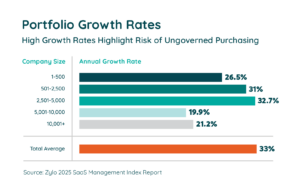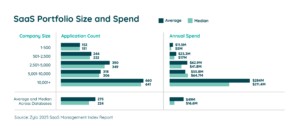Table of Contents
Updated on November 4, 2025 with fresh information, stats, and perspectives.
As software solutions expand, so does the need to manage them. This means identifying, monitoring, and managing enterprise applications across multiple layers of business. Then, aligning these tools with business objectives to deliver the maximum value possible to the organization. In a nutshell: application portfolio management.
What Is Application Portfolio Management (APM)?
Application portfolio management (APM) is the practice of governing, managing, and optimizing an organization software inventory—including SaaS. It involves:
- Establishing a system of record of all applications, enabling full inventory visibility across stakeholders
- Ensuring compliance and governance across the whole organization
- Evaluating and rationalizing software assets to improve utility and value
- Managing the SaaS renewal lifecycle
At a high level, your application portfolio management strategy ensures your software investments drive positive outcomes for the business by aligning applications to business needs.
For SaaS, this means inventorying assets across your entire SaaS stack and using data insights to rationalize your portfolio. The most successful organizations, weave APM into the architecture of their company as an ongoing process that entails:
- Evaluating costs
- Creating standards
- Driving business outcomes
Together, this creates a system that is essential to combat the sprawling and hidden costs of software assets. All the while, it becomes a consistent source of portfolio optimization and improved ROI.
For a more in-depth description of the practice, read more here: ‘What is application portfolio management?’
Why Do You Need Application Portfolio Management?
Application portfolio management is important to organizations, because it:
- Aligns application utility to business needs
- Supports scalability
- Reduces SaaS costs
Align App Utility to Business Needs
In 2025, Zylo data show that the average large enterprise has 660 applications in their portfolio. Yet, not all deliver value to the business.
Enterprise application portfolio management ensures SaaS works for the business by tying application utility to business needs. That means ensuring every SaaS asset is driving value for the enterprise and is doing so as efficiently as possible.
“We root everything in business capabilities. We want to know—whether it’s people, process, technology, or information—how it aligns to business capabilities, because then we know exactly what it’s doing for us and how we are driving business value.”
— Leah Tubb, former Program Manager of IT Architecture, Planning & Innovation at Atlassian
Support Scalability
Managing all applications with the same rigor is not scalable. As portfolios grow—22% on average for enterprises—managing them becomes even more confounding. Each application comes with its own:
- Pricing model
- Licensing structure
- Renewal timeline
- Terms of use
Any enterprise concerned with scalability must be ready to adopt SaaS-conscious APM.

Reduce SaaS Costs
At large enterprises, SaaS spend amasses to an incredible $284M annually—on average. Without application portfolio management:
- Costs will continue to grow
- Inefficiencies will form
- Software will lose utility

Today, more money is already spent on SaaS than on-premises software. Even IDC projects that, by 2026, SaaS spending will comprise two-thirds of all enterprise application revenue. In 2025, Gartner projects SaaS spending to grow 19.2% to total $299B, up from $247B in 2024.

The good news? Zylo’s 2025 SaaS Management Index reports that 91.2% of IT leaders recognize the cost-saving potential of software optimization. Luckily, opportunities to reduce SaaS costs are plentiful.
What does it look like in practice?
👉 Check out these application portfolio management use cases.
The Benefits of Application Portfolio Management
What are the benefits of application portfolio management for your business? When it comes to SaaS, we see these four key benefits:
- Get the right tools for the business
- Streamline your portfolio
- Maximize software investments
- Eliminate wasted spending
Get the Right Tools for Business
Effective enterprise application portfolio management aligns tools to business needs. Establishing governance ensures guardrails are in place for new purchases while giving employees tool autonomy. This ensures:
- Improve productivity, collaboration, and innovation across the business
- Prevent shadow IT, or unauthorized software purchases
- Employees have easy access to approved tools and a pathway to request new software
Streamline Your Portfolio
APM is an essential practice for reducing the size and complexity of your SaaS portfolio. It helps you:
- Only pay for the software you need
- Reduce administrative burden for IT and app owners
- Improve efficiency and collaboration
- Strengthen data connectivity across the enterprise
Maximize Software Investments
When you buy software, you want it to benefit the business. Application portfolio management helps you do more with your existing software and improve ROI by:
- Negotiating better pricing on enterprise contracts
- Improving user adoption and utilization rates
- Standardizing a list of preferred applications
Eliminate Wasted Spending
In the average tech stack lies an abundance of waste that application portfolio management is poised to eliminate:
- Duplicate contracts and spend sources
- Unused licenses
- Redundant applications
The powerhouse combination for waste removal includes:
- Reducing license counts in line with business needs
- Canceling unnecessary redundant software
- Consolidating duplicate contracts for increased purchasing power
- Eliminating expense purchases
Tips to Get Started With Application Portfolio Management
To get started with application portfolio management, follow these tips:
- Assign a dedicated application portfolio manager
- Gain visibility into your entire SaaS portfolio
- Make it a practice, not a one-time project
- Collaborate with stakeholders across the business
- Establish an app rationalization strategy
Assign a Dedication Application Portfolio Manager
Today, many organizations have a substantial headcount for IT architecture and APM functions—but they may not have a dedicated focus on SaaS. Assign an application portfolio manager dedicated to SaaS to help:
- Ensure stakeholder alignment
- Maintain a trusted SaaS system of record
- Facilitate key SaaS Management processes
- Navigate complex licensing and pricing models, typically different from vendor to vendor
Atlassian Reinforces Enterprise Architecture with Zylo SaaS Management
Learn how Atlassian’s enterprise architecture uses Zylo to encourage innovation and rapid growth while constantly rationalizing their application portfolio.
Gain Visibility into Your Entire SaaS Portfolio
Before you can begin to optimize your portfolio and spend, you must have a foundation of visibility. This means understanding:
- All the SaaS applications in your portfolio
- Overall SaaS spend
- Departmental- and individual-level usage
Because IT manages just 26% of SaaS spend and 16% if apps, lack of visibility means blind spots. As a result, this fragmented view makes it difficult to effectively reduce spend, mitigate risk, and improve efficiency.
To get visibility, begin by identifying what applications you are using and who is using them. From there, pinpoint their costs and determine who is responsible for their management and purchase. The first step in solving a problem is seeing the problem.
“I’m telling you, you’ve got a problem. You just don’t know that it’s a problem yet until you start going down this path and trying to identify everything that’s out there.”
— Ridge Fussell, Sr. Manager of FinOps at The Home Depot
Make It a Practice, Not a One-Time Project
Possibly the most important part of establishing APM is treating it as a program, not a project.
- Project: A one-and-done approach.
- Program: An ongoing business practice.
Application portfolio management means establishing a system of good governance and processes in the enterprise architecture of an organization. This ensures the benefits we’ve discussed are permanent, long-lasting, and continuous.
Collaborate with Stakeholders across the Business
In enterprise application portfolio management, cross-functional collaboration is essential to save money, reduce risk, and improve efficiency. That includes stakeholders from:
- IT
- Software Asset Management
- Procurement
- Finance
- Security
- Business units
Software company Atlassian recognized this team-sport-approach as the key to rationalizing their portfolio for their global workforce.
Leah Tubb, Atlassian’s former program manager, partnered with Enterprise Architecture (EA) to make software decisions based on business requirements. As a result, they were better equipped to centralize the enterprise’s entire portfolio and bring visibility to what was purchased at all levels of business.
On the SaaSMe Unfiltered podcast, Tubb explained how she collaborated with EA: “Let’s have a discussion. Are those [applications] the right ones? Are they actually serving the needs that they need to serve, or what can we do better? ”
Looking for more tips?
👉 Check out these APM best practices.
How Zylo Enables Effective Application Portfolio Management
For all of its benefits, establishing an effective application portfolio management in the enterprise can be difficult to get off the ground. But it doesn’t have to be. Zylo offers comprehensive application portfolio management software that puts you in total control of your SaaS portfolio.
- Comprehensive, always-on SaaS discovery
- Centralized system of record
- Insights for data-driven decision making
Comprehensive SaaS Discovery and System of Record
Complete and ongoing visibility is the foundation to executing application portfolio management at your organization. Zylo’s AI-powered discovery finds all of your SaaS wherever it hides in your enterprise—whether properly cataloged or hidden in expense purchases.
Paired with data from direct integrations, it results in a SaaS system of record. With this centralized SaaS data, you easily see:
- SaaS spend and sources
- License utilization and adoption
- Contracts and renewal dates
This allows you to answer questions about your software, such as:
- What applications do you have?
- How do applications align to business capabilities?
- Where are redundancies?
- Who owns what?
- How much is being spent?
Insights for Data-Driven Decision Making
Zylo Insights delivers recommendations prioritized by impact, whether it’s newly expensed subscriptions, low license usage, or expired contracts. This empowers you to:
- Identify risky and redundant applications
- Reclaim licenses and rightsize contracts
- Negotiate renewals with more leverage
Uncover more value, quickly with instant recommendations for rationalization and rightsizing opportunities. With Zylo, you’ll no longer have to waste time searching for data with manual processes, allowing you to take immediate action on savings opportunities.
The Bottom Line of Application Portfolio Management
An application portfolio management program empowers enterprises to use the right tools, improve productivity, and maximize software investments. To be effective, it requires dedicated SaaS expertise and a collaborative mindset.
Leading organizations rely on Zylo for the discovery and insights to drive business results. Discover how you can use Zylo to drive your APM initiatives forward. Request a personalized demo today.
FAQs About Application Portfolio Management
What is the concept of application portfolio management?
Application Portfolio Management (APM) is the strategic practice of governing and optimizing an organization’s software inventory—including SaaS. It ensures all applications are aligned with business needs, improve ROI, and reduce costs by rationalizing tools, eliminating redundancies, and maintaining ongoing governance across the tech stack.
What is the difference between application portfolio management and CMDB?
APM focuses on aligning software investments with business goals, optimizing utility, and reducing costs. A Configuration Management Database (CMDB), on the other hand, stores information about IT assets and their relationships but doesn’t provide cost, usage, or business value insights. APM often enriches CMDB data for more strategic decisions.
What is an example of portfolio management?
With Zylo, Adobe discovered 2,600 applications—a portfolio also rife with redundant applications. Through rationalization, the team consolidated 7 sales platforms to 1, decommissioned 9 observability tools, and canceled 18 project portfolio management tools. This resulted in efficiency gains and contributed to the company’s total cost savings and avoidance of $60M.
What is the difference between application portfolio management and enterprise architecture?
Enterprise Architecture (EA) defines the structure and standards for technology across an organization. APM complements EA by actively managing the application layer, tracking usage, spend, and alignment to business goals. While EA is strategic and structural, APM is operational and optimization-focused.
What does an enterprise applications manager do?
An Enterprise Applications Manager oversees the lifecycle of business-critical applications. They manage vendor relationships, ensure systems meet business needs, optimize licensing, support renewals, and drive adoption. Their goal is to maximize application ROI, improve user experience, and align technology with strategic priorities.


 — Ridge Fussell, Sr. Manager of FinOps at The Home Depot
— Ridge Fussell, Sr. Manager of FinOps at The Home Depot